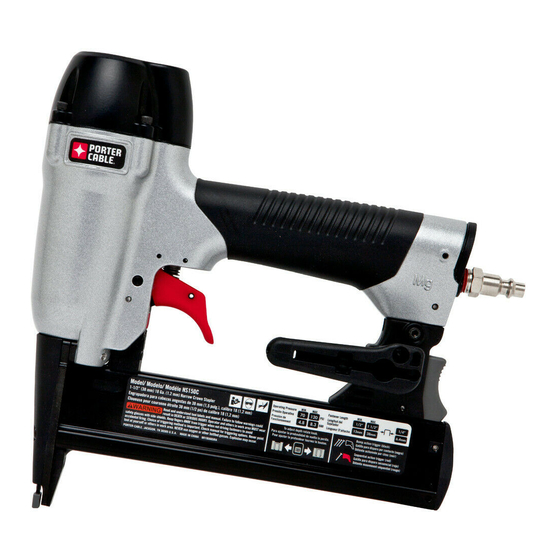
Advertisement
Quick Links
CrowN Narrow Stapler
Instruction manual
When using any pneumatic tool, all safety precautions, as outlined below, should be followed to avoid the risk of death or serious injury. Read and understand all instructions
before operating the tool.
DEFINITIONS - SAFETY GUIDELINES
The definitions below describe the level of severity for each
signal word. Please read the manual and pay attention to
these symbols.
Indicates
an
imminently
situation which, if not avoided, will result in death or
serious injury.
Indicates
a
potentially
situation which, if not avoided, could result in death or
serious injury.
Indicates
a
potentially
situation which, if not avoided, may result in minor or
moderate injury.
Used without the safety alert symbol
indicates a situation which, if not avoided, may result in
property damage.
• Actuating tool may result in flying debris,
collation material, or dust which could harm
operator's eyes. Operator and others in work
area MUST wear safety glasses with side
shields. These safety glasses must conform to
ANSI Z87.1 requirements (approved glases have
"Z87" printed or stamped on them). It is the
employer's responsibility to enforce the use of
eye protection equipment by the tool operator
and other people in the work area. (Fig. A)
• Always wear appropriate personal hearing
and other protection during use. Under some
conditions and duration of use, noise from this
product may contribute to hearing loss. (Fig. A)
• Use only clean, dry, regulated air. Conden sation
from an air compressor can rust and damage the
internal workings of the tool. (Fig. B)
• Regulate air pressure. Use air pressure
compatible with ratings on the nameplate of
the tool. [Not to exceed 120 psi (8.3 bar).] Do not
connect the tool to a compressor rated at over
175 psi. The tool operating pressure must never
exceed 175 psi even in the event of regulator
failure. (Fig. C)
• Only use an air hose that is rated for a
maximum working pressure of at least 150 psi
(10.3 bar) or 150% of the maximum system
pressure, whichever is greater. (Fig. D)
• Do not use bottled gases to power this tool.
Bottled compressed gases such as oxygen,
carbon dioxide, nitrogen, hydrogen, propane,
acetylene or air are not for use with pneumatic
tools. Never use combustible gases or any other
reactive gas as a power source for this tool.
Danger of explosion and/or serious personal
injury may result. (Fig. E)
• Use couplings that relieve all pressure from
the tool when it is disconnected from the
power supply. Use hose connectors that shut
off air supply from compressor when the tool is
disconnected. (Fig. F)
• Disconnect tool from air supply when not in
use. Always disconnect tool from air supply
and remove fasteners from magazine before
leaving the area or passing the tool to another
operator. Do not carry tool to another work
area in which changing location involves the
use of scaffoldings, stairs, ladders, and the
like, with air supply connected. Do not make
adjustments,
remove
magazine,
maintenance or clear jammed fasteners while
connected to the air supply. If the contact trip
is adjusted when the tool is connected to the air
supply and nails are loaded, accidental discharge
may occur. (Fig. G)
• Connect tool to air supply before loading
fasteners to prevent an unintentional fastener
discharge during connection. The tool driving
mechanism may cycle when the tool is connected
to the air supply. Do not load fasteners with the
trigger or the contact trip depressed to prevent
unintentional driving.
• Do not remove, tamper with, or otherwise
cause the tool, trigger, or contact trip to
NS150C
SAVE THESE INSTRUCTIONS
IMpORTANT SAFETY INSTRUCTIONS FOR pNEUMATIC TOOLS
hazardous
hazardous
hazardous
Fig. A
Fig. B
Fig. C
120 psi
8.3 bar
70 psi
4.9 bar
Fig. D
Fig. E
Fig. F
perform
Fig. G
exteRnAl pARts
A. Trigger
B. Contact trip
C. No-mar pad
D. Low nail indicator window
E. Magazine
F. Magazine Release
G. Air Inlet
H. Rear exhaust
I. Adjustable belt hook
J. Depth adjustment wheel
nAil specificAtions
Lengths
Diameters
Air Inlet
Staple Crown
Fig. 1
I
A
J
D
E
B
NS150C
C
NS150C
1/2'' – 1-1/2"
(12.7 mm – 38.1 mm)
18 gauge (calibre 18)
1/4" NPT (1/4 po)
1/4" (6.4 mm)
H
G
F
Advertisement

Summary of Contents for Porter-Cable NS150C
- Page 1 D. Low nail indicator window CrowN Narrow Stapler E. Magazine F. Magazine Release G. Air Inlet H. Rear exhaust I. Adjustable belt hook J. Depth adjustment wheel NS150C Instruction manual nAil specificAtions NS150C Lengths 1/2'' – 1-1/2" (12.7 mm – 38.1 mm) Diameters...
- Page 2 become inoperable. Do not tape or tie trigger Fig. H or contact trip in the on position. Do not remove spring from contact trip. Make daily inspections for free movement of trigger and contact trip. Uncontrolled discharge could result. • Inspect tool before use. Do not operate a tool if any portion of the tool, trigger, or contact trip is inoperable, disconnected, altered, or not working properly.
-
Page 3: Cold Weather Operation
• ANSI S12.6 (S3.19) hearing protection, Fig. 2 Fig. 3 • NIOSH/OSHA respiratory protection. Before operating this tool, carefully read and understand all instructions in Important Safety Instructions. ASSEMBLY Disconnect the tool from the air supply and remove fasteners from magazine before making adjustments or personal injury may result. -
Page 4: Troubleshooting Guide
Compressor will be sufficient for tools at all production rates. Portable Handcarry 5.5 HP Gas 2 HP Elec. 8 HP Gas Industrial 3.2 – 4 CFM 8 – 9 CFM 14 – 16 CFM 23+ CFM Compressor will be sufficient at slow or moderate production rates, but may have difficulty at 39,1+ CMM 5,4 –...













